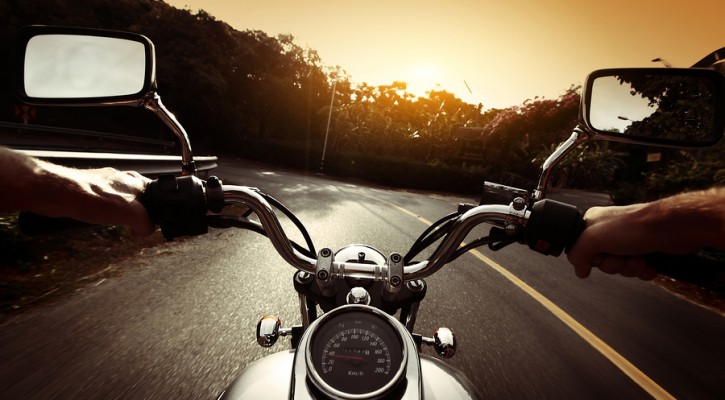Your First Motorcycle Accident – Now What?!
April 5, 2014
No one is invincible, and odds are that you may one day find yourself red-faced and reeling after your first motorcycle accident. However, there is no reason to be too embarrassed, after all, it happens to the best of us. If you come out alive and in one piece, then you’ve already succeeded where many others have failed.
Next comes the “now what” part of handling a motorcycle accident. This part is simple if you follow this 7-step guide:
1. Remain calm. This is no time to pick a fight (even if you feel it’s called-for). Whether you’re a victim or at fault, freaking out will only make things worse.
2. Move the motorcycle (or pieces of motorcycle) to a safe area, such as the shoulder of the road.
3. Check to see if who is involved and if anyone is hurt. Immediately call 911 if somebody has been injured. Even seemingly minor aches and dizziness could be a sign of something more serious.
4. Call the police. This will provide an objective report to prove who, if anyone, is truly responsible for the crash. If the police can’t make it to the scene, then file an accident report through your state’s DMV.
5. Exchange Info. You will need to get all the information necessary to file a report with your insurance company. Likewise, the other driver will need to have all of your information for their insurance company. This includes:
-
Driver and passenger names
-
License plate numbers
-
Insurance info
-
Makes and models of all the vehicles involved
-
Contact info for any eyewitnesses
-
Location of the accident
-
Name and badge number of responding officers
6. Document the Scene. Snap some pictures with your phone or camera. They will come in handy during the claims process.
7. File your insurance claim.
Race Tires Vs Street Tires
April 4, 2014
Some might be forgiven for thinking that racing tires would be a safer choice. After all, they keep motorcycles glued to the rack racing at incredible speeds and turning dangerously close to the asphalt. However, racing tires were made for just that purpose. They weren’t made for the other common conditions many street riders face, such as road damage, weather conditions. and various styles of winding, rising and dropping roads.
So, if you’re replacing your tires, be sure to choose the right tires for the job. Research online, consult your manufacturer’s handbook and talk to people at the shop.
Top Tech Tips
April 4, 2014
Get some great motorcycle maintenance tips from Joe Conry to ensure motorcycle safety and smooth riding.
https://www.youtube.com/watch?v=-JSM3MTINTs&feature=youtu.be
The Most Common Beginner Mishaps
April 3, 2014
1. Buying the Wrong Motorcycle. Many beginners buy too much weight and too much power, resulting in a bike they cannot control. See our bike buying guide for new riders.
2. Overestimating skills. Going from the training of an empty parking lot into downtown traffic during rush hour is not a good idea.
3. Underestimating other drivers’ stupidity. There are a ton of terrible drivers on the roads, and a new rider should never underestimate the stupidity of other drivers.
4. Assuming you’re not invisible. Cars and trucks have a hard time seeing motorcycles, especially when turning or changing lanes. Always assume that you are invisible to every other driver on the road.
5. Riding with a passenger. Before you let a passenger on the back of your bike, get a few thousand miles and a year of experience under your belt.

Miss Fires
April 3, 2014
This motorcycle group doesn’t require much knowledge, experience, or even a license. You can even join if you don’t have a bike yet. See the full story over at nytimes.com:
Top Ten Tips for New Riders
April 2, 2014
So, you’ve fallen in love with the thrill of motorcycle riding and are ready to dive in. Well, before you begin riding around town on two wheels, there are a few essential tips all new riders should know. So, let us bring them to your attention here and now:
1. Take a motorcycle safety course. Not only will it make you a safer rider – and possibly prevent you from becoming road-ground hamburger meat – it could also make your insurance rates lower. Also, some dealerships offer motorcycle discounts when to take a safety class at their location.
2. Get the right gear. One of the first, and most-often repeated terms you will hear from motorcycle safety experts is wear All The Gear All The Time (ATGATT). Since two wheels are the only thing seperating you from the road, wearing the right equipment is extremely important. 3. Get some tough boots. Boots are shoes that are sturdy will provide better protection for you feet, as well as better balance and control.
4. Don’t get cocky. Never overestimate your skills, and never get overconfident. Riding within your skill level will prevent embarassing and possibly fatal rookie mistakes. If you want to push your limits, then consider taking a class at your local race track to learn the proper throttle, turning and stopping methods for expert riders.
5. Don’t tailgate. Motorcycles may have a shorter stopping distance than cars, however it is not as safe for motorcyclists to slam on the brakes during an emergency. Since they only have two wheels, and often don’t have antilock brakes, it’s easier for motorcycles to lose control when making an emergency stop. So always keep plenty of distance between yourself and other drivers.
6. Always have an escape route. By leaving plenty of room between your motorcycle and other vehicles, you will have more time to react in an emergency situation. Buy yourself even more time by always having an escape route in case of a traffic accident.
7. Mind the weather. Rain, wind, snow and ice are much more dangerous on a motorcycle.
8. Avoid distraction. Part of the joy of motorcycle riding is the rush of a life-or-death state of hyper-alert thinking. Don’t risk your life and cheapen the experience by fiddling with your phone, day dreaming or sipping on a latte.
9. Look twice. Always, always double check before turning, changing lanes or even slowing down. Any changes in your current path may go unseen by other drivers.
10. WEAR A HELMET. This is the main defense in case of an accident, and the only way to keep your face from peeling off on the road if you fly off the motorcycle. Plus, it keeps the bugs and road debris from hitting you in the face while riding.
Now that you’ve heard the 10 essential tips, you’re ready to get started on the path to becoming a motorcycle rider! Enjoy!
Statistics Every Smart Rider Knows
April 2, 2014
There are a few statistics that all motorcyclists should be aware of:
– 3% of vehicle registrations are for motorcycles, while motorcycles account for more than 15% of vehicle fatalities. This staggering statistical combo shows that riders are at a much higher risk of death than any other vehicle.
– Roughly 50% of motorcycle rider deaths occur in crashes involving only the motorcycle. This means that despite all the terrible, distracted and disgruntled drivers out there, the most dangerous person out there is yourself.
– 40% of those fatal crashes happened when the motorcycle operator rode after drinking.
The main lesson from the statistics is obvious: Always ride smart, which means being safe, hyper-aware and sober.

Reviewing Motorcycle Safety
April 2, 2014
In Wisconsin, Eu Claire police and instructors are reminding riders to review motorcycle safety for the spring riding season. See the full story here:
http://www.weau.com/home/headlines/Motorcycle-Safety-keeping-safe-on-the-road-253281631.html?ref=631
Passengers
April 1, 2014
If you have ever been a passenger on a motorcycle, then you may know the feeling of being completely helpless, and yes, a little bit scared. If you’re lucky, then you were riding with an experienced motorcyclist that respected your comfort and safety and made the whole experience more fun than frightening.
However, if you’ve ever ridden with an inexperienced person, then you probably understand that passengers and newbies don’t mix. It takes lots of practice to have the skills required to ride with a passenger on the back. For this reason, you should wait until you have a lot of time and miles under your belt before letting anyone on the back of the bike. And even then, be sure to practice turning and stopping in an empty parking lot – preferably with someone who knows a thing or two about motorcycles and passengers – or else you’re going to be putting two lives at risk.
Anime-Inspired Motorcycle
April 1, 2014
If you’re a manga fan, then get ready for a motorcycle built just for you! This Honda bike is made with the aesthetic design of Japanese manga and anime, with angular lines and sharp geometry that will make you go “Whawhaaaa?!”
